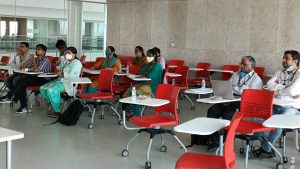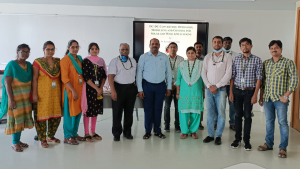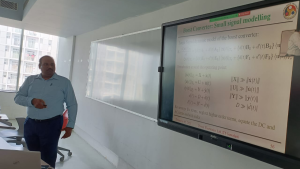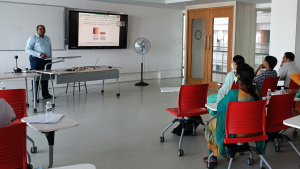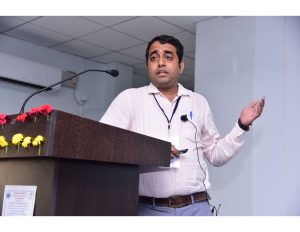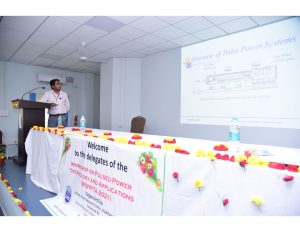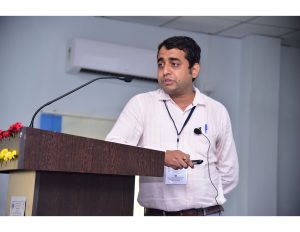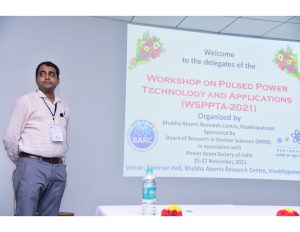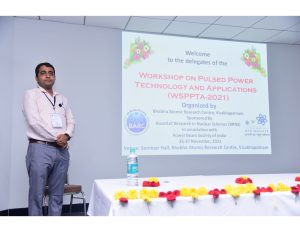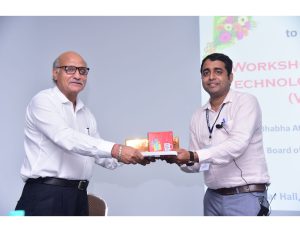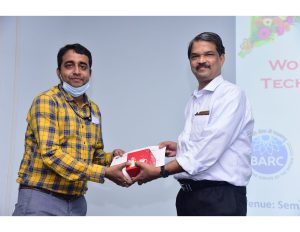Recent News
- Dynamic economic and emission dispatch with renewable energy integration December 28, 2021
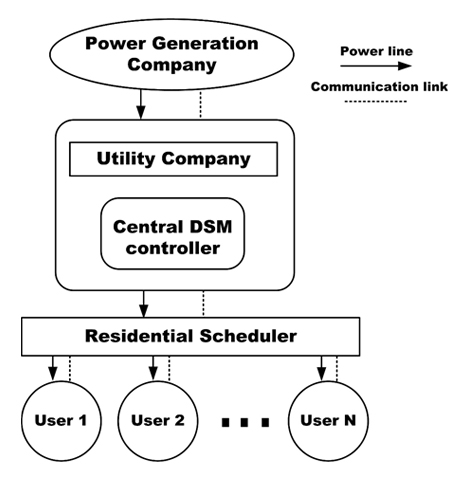 Nowadays, the energy demand of the present electrical power industry is increasing exponentially, and most of the electricity production depends on fossil fuel resources. A research paper titled “Dynamic Economic and Emission Dispatch with Renewable Energy Integration Under Uncertainties and Demand Side Management”, published by Dr B Lokeshgupta, Assistant Professor, Department of Electrical and Electronics Engineering, SRM University-AP, Andhra Pradesh, answers some of the pertinent questions regarding reducing the environmental pollution level.
Nowadays, the energy demand of the present electrical power industry is increasing exponentially, and most of the electricity production depends on fossil fuel resources. A research paper titled “Dynamic Economic and Emission Dispatch with Renewable Energy Integration Under Uncertainties and Demand Side Management”, published by Dr B Lokeshgupta, Assistant Professor, Department of Electrical and Electronics Engineering, SRM University-AP, Andhra Pradesh, answers some of the pertinent questions regarding reducing the environmental pollution level.Integration of renewable energy resources (RERs) along with demand-side management (DSM) is almost inevitable in the present scenario to meet the growing energy demand with minimum environmental pollution. This work proposes a combined model of dynamic economic and emission dispatch (DEED) and DSM to integrate renewable energy resources (RERs). In this analysis, the DSM load-shifting scheme is incorporated with the DEED problem to obtain the generation side operational benefits as well as the reduction in environmental pollution level. In this study, various smart home appliances and their complex constraints are included in the DSM load shifting process. The variability and stochastic nature of the load demand and RERs such as solar, wind are modelled with Normal, Beta, and Weibull distribution functions, respectively. The proposed model is implemented in both deterministic and stochastic approaches with the help of the non-dominated sorting genetic algorithm (NSGA-II) and the Monte Carlo Simulation (MCS) approach. In the stochastic model, the MCS approach appropriately handles the uncertainties of system load demand and RERs. Four different case studies are carried out in the simulation analysis to show the impacts of RERs and DSM integration on the traditional DEED problem.
Meeting the excessive energy demand with the minimum environmental pollution is a challenging task. The integration of RERs such as wind and solar into the grid is one of the superior solutions for this issue. However, the variability and uncertainty of the RERs bring challenges to the power system operation. Energy management schemes such as demand-side management (DSM) methods can help the power industry address the challenges of RERs integration. That is why the combination of renewable energy integration and DSM is one of the key solutions in the smart grid environment to meet the increased energy demand with the lowest possible energy cost and minimum pollution level. The RERs and DSM combination gives several financial, environmental, and technical benefits to the power industry along with a better system operation.
The dynamic economic and emission dispatch (DEED) is one of the widely adopted tools in the operation and planning of power systems. Both DEED and DSM are the essential tools in the smart grid environment for efficient energy management with the concern of economic and environmental aspects. The DEED’s primary task is to obtain the optimal scheduling of generators with minimum cost and emission for the given load demand. At the same time, the DSM’s primary goal is to improve the optimal values of system objective functions by shifting or managing the controllable loads of consumers. This work introduces a combined stochastic optimisation model of DEED and DSM scheme with the integration of solar and wind energy to show how DSM and RERs bring benefits to a generation company, and also to get better optimal operation cost and emission values simultaneously. The DSM load-shifting scheme is implemented in this study with the help of 10,000 active residential consumers. The effectiveness of the proposed combined model has been tested on a system of six thermal generating units, one wind-powered generator, and one solar-powered generator. The MCS approach and NSGA-II method are used in this paper to solve the proposed stochastic combined DEED and DSM optimisation model.
From the overall analysis, it is recognized that the implementation of the DSM load-shifting scheme along with RERs integration is essential for future smart grids to improve the financial savings of generation companies as well as to reduce the environmental pollution level. The paper is written in collaboration with Dr S Sivasubramani, Associate Professor, Department of Electrical Engineering, Indian Institute of Technology, Patna.
In future, the proposed DSM optimisation can be extended with the inclusion of a neighbourhood power-sharing model in the environment of multiple smart home consumers and prosumers. The proposed DSM model can also be integrated with the distribution network planning and operation problems to enhance the financial and technical benefits of distribution companies.
Continue reading → - Guest Lecture on “DC-DC Converters: Operation, Modelling and Control for Solar and Wind Applications” December 27, 2021
The Department of Electrical and Electronics Engineering at SRM University-AP organized a guest lecture titled “DC-DC Converters: Operation, Modelling and Control for Solar and Wind Applications” on December 3, 2021, at 11.00 am IST as part of the Departmental Lecture Series.
An eminent resource person, Dr. Ravindranath Adda, Assistant Professor, Department of Electrical and Electronics Engineering, IIT Guwahati, delivered the intriguing talk as the guest lecture. Many undergraduate students of EEE, research scholars and faculty members of SRM University-AP attended the riveting session.
In his lecture, Dr Adda discussed about the importance of DC-DC converters for solar PV and Wind power applications and emphasized the different non-isolated and isolated converter topologies. He also explained the output power variation of the solar PV or wind turbine as a function of weather conditions, and hence the requirement of DC-DC converters and storage systems to transfer the energy from non-conventional energy sources.
Finally, he discussed about the research scope of DC-DC converters, to increase gain, expedite efficiency, reduce the bulk, dynamic modelling, and large scale and small-scale modelling of DC-DC converters.
The lecture concluded with an energetic note with all the participants looking forward to putting to use all the knowledge and information that they had acquired because of it.
Continue reading → - Invited talk at Workshop on Pulse Power Technology and Applications (WSPPTA-2021) December 24, 2021
Dr Somesh Vinayak Tewari delivered an invited talk on “High Power Closing Switches” on November 25, 2021, during the Workshop on Pulse Power Technology and Applications (WSPPTA-2021) held from November 25, 2021, to November 27, 2021, at Bhabha Atomic Research Centre (BARC) Facility, Visakhapatnam, sponsored by Board of Research in Nuclear Sciences (BRNS), Department of Atomic Energy, Government of India in association with Power Beam Society of India.
The workshop served as a platform for pedagogical presentations, discussions on intricacies of pulsed power technology and mutual interactions among young researchers, engineers and students from academia and applied research laboratories and talks were delivered by scientists of BARC, IPR, DRDO, CEERI, professors from IIT, IISc and experts from industry.
Dr Tewari delivered a talk on “High Power Closing Switches”, highlighting the working principle, mechanism, and applications of vacuum switches like ignitron, thyratron, pseudo spark gap, gas-filled spark gap switches, liquid and solid dielectric switches, magnetic switches, and modern-day semiconductor switches.
After his talk, Dr Tewari was highly appreciated and felicitated by Dr D. C. Pande, Dr Raja Ramana Distinguished Fellow of DRDO. The proceedings were compiled in the form of book chapters and circulated to participants.
Continue reading → - Design and implementation of frequency controller for wind energy-based hybrid power system November 10, 2021
 Dr Tarkeshwar Mahto, Assistant Professor, in the Department of Electrical and Electronics Engineering has published a paper titled “Design and Implementation of Frequency Controller for Wind Energy-Based Hybrid Power System Using Quasi-Oppositional Harmonic Search Algorithm” in the reputed research journal, Energies.
Dr Tarkeshwar Mahto, Assistant Professor, in the Department of Electrical and Electronics Engineering has published a paper titled “Design and Implementation of Frequency Controller for Wind Energy-Based Hybrid Power System Using Quasi-Oppositional Harmonic Search Algorithm” in the reputed research journal, Energies.An innovative union of fuzzy controller and proportional-integral-derivative (PID) controller under the environment of fractional order (FO) calculus is described in the present study for an isolated hybrid power system (IHPS) in the context of load frequency control. The proposed controller is designated as FO-fuzzy PID (FO-F-PID) controller. The undertaken model of IHPS presented here involves different independent power-producing units, a wind energy-based generator, a diesel engine-based generator and a device for energy storage (such as a superconducting magnetic energy storage system). The selection of the system and controller gains was achieved through a unique quasi-oppositional harmony search (QOHS) algorithm. The QOHS algorithm is based on the basic harmony search (HS) algorithm, in which the combined concept of quasi-opposition initialization and HS algorithm fastens the profile of convergence for the algorithm. The competency and potency of the intended FO-F-PID controller were verified by comparing its performance with three different controllers (integer-order (IO)-fuzzy-PID (IO-F-PID) controller, FO-PID and IO-PID controller) in terms of deviation in frequency and power under distinct perturbations in load demand conditions. The obtained simulation results validate the cutting-edge functioning of the projected FO-F-PID controller over the IO-F-PID, FO-PID and IO-PID controllers under non-linear and linear functioning conditions. In addition, the intended FO-F-PID controller, considered a hybrid model, proved to be more robust against the mismatches in loading and the non-linearity in the form of rate constraint under the deviation in frequency and power front.
The research group believes that the study will boost the use of renewable energy utilization for fulfilling energy requirements in a more reliable and stable manner. In future, they plan to use the knowledge gained from the isolated systems to develop a Multi-Migrigrid system.
Collaborations:
- Department of Electrical and Electronics Engineering, M S Ramaiah Institute of Technology, Bengaluru 560054, India
- The Berkeley Education Alliance for Research in Singapore, The National University of Singapore, Singapore 138602, Singapore
- Clean and Resilient Energy Systems (CARES) Lab, Texas A&M University, Galveston, TX 77553, USA;
- Department of Electrical Engineering, College of Engineering, Taif University, Taif 21944, Saudi Arabia
- Search for compact IEC systems traversing disciplines June 9, 2021
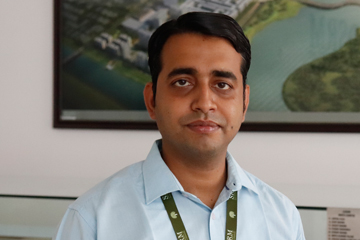 “Compact Inertial Electrostatic Confinement D-D Fusion Neutron Generator” is an imbuing research paper co-authored and published by Dr Somesh Vinayak Tewari, Assistant Professor in the Department of Electrical and Electronics Engineering (EEE), SRM University – AP, in the scientific journal, Annals of Nuclear Energy.
“Compact Inertial Electrostatic Confinement D-D Fusion Neutron Generator” is an imbuing research paper co-authored and published by Dr Somesh Vinayak Tewari, Assistant Professor in the Department of Electrical and Electronics Engineering (EEE), SRM University – AP, in the scientific journal, Annals of Nuclear Energy.This paper is part of an interdisciplinary work leveraging the areas of both electrical engineering and physics. Inertial Electrostatic Confinement (IEC) Systems are simple, compact and operate on high voltage discharge in Deuterium- Deuterium (D-D)/ Deuterium-Tritium (D-T) gases between concentric grids for neutron generation. Such systems find considerable applications in the detection of explosives and illicit materials, radiography, tomography, and neutron well logging. The IEC system cathode temperature is measured with a Fibre Bragg Grating (FBG) during the measurement of neutrons from the system. FBG is optical fibre sensors that can be used for sensing temperature by recording the Bragg wavelength shift. The advantage of such measurements is that they can be used in environments such as electric arcs and plasmas, chemical and nuclear zones unaffected by electromagnetic fields such that the signals can be monitored remotely.
The production of neutron fluxes for the above-mentioned applications is through radioisotopes, accelerators, or nuclear reactors with the inherent nature of their complexity, hazards, and problem of residual radioactivity. Additionally, such systems require a considerable amount of shielding and Dr Tewari puts forth such factors that prompt further research in the area of the development of much simpler compact IEC systems.
The said research project has been carried out under the scheme of “Mentoring of Engineering Teacher by an INAE Fellow”, financially supported by the Indian National Academy of Engineering. The work goes forward in close collaboration with Pulsed Power & Electromagnetic Division, Beam Technology Development Group, Bhabha Atomic Research Centre (BARC)-Vishakhapatnam.
The future projects of Dr Tewari involve working on simulations related to the compact IEC for study, analysis, optimization of different parameters of an IEC system and related experimentation in collaboration with BARC.
Continue reading →


